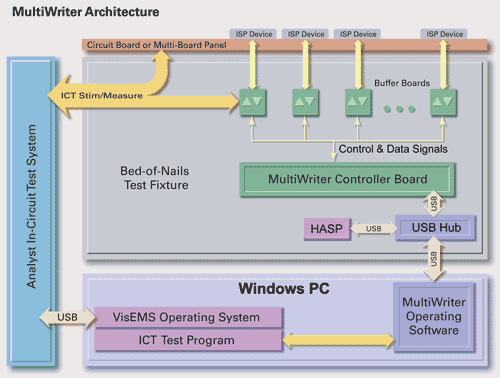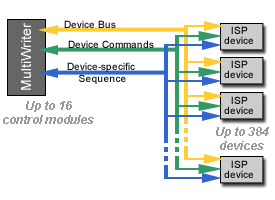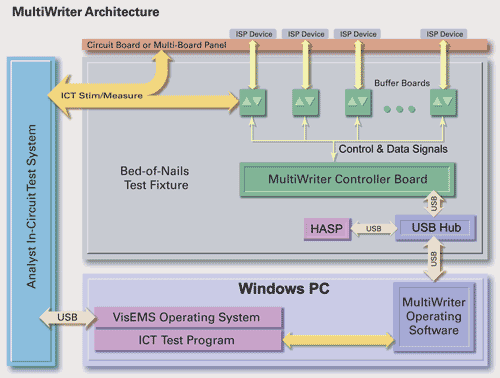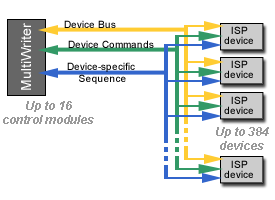
The MultiWriter Part Programming System solves the throughput and cost problems of earlier ISP programming techniques used in-line on in-circuit testers (ICT) and with 'dongle’-based approaches used at functional test.
Using CheckSum’s patented simultaneous programming technology to program up to 384 serial parts in a single pass, MultiWriter technology makes on-board part programming practical, affordable and productive.
And fast. Serial Flash, EEPROMS, embedded microcontrollers, and FPGAs are programmed at near-data book speeds. Since the contents of Phase Change Memory (also known as PCM, PCME, PRAM, PCRAM, and C-RAM) can be lost because of the high temperatures needed to solder the device to a board, on-board programming is required.
Using the Data Encryption Protection option insures your IP (Intellectual Property) is not at risk anywhere in the world. Unique data (e.g. serial number, date code, MAC address, calibration data, etc) can be written to individual chips, as they are being gang-programmed.
A unique test fixture-based controller and buffer card architecture reduces cost, improves signal quality. A USB 2.0 bus directly from the controller to computer and MultiWriter software designed for speed complete the productivity equation.
Software architecture enables simultaneous part programming
MultiWriter’s ability to program ISP devices simultaneously rests on its patented architecture that allows it to program up to 384 serial ISP devices per board or multi-up panel at high speed.
The total programming time is identical for a single chip on a single board, one chip per board on a multiple panel assembly, or any combination in between. Device-specific code is programmed following the simultaneous programming step. Since the amount of device-specific code is small compared to the code common to all chips, total programming time is affected very little, if at all.

For example, benchmark results conducted by CheckSum show that MultiWriter can program one or five Freescale 9S12H128 microcontrollers in the same amount of time using the BDM (Background Debug Mode) bus. Programming speed is limited by the chip, while the memory size for this microcontroller is 128k, but only 64k was programmed. With MultiWriter, the software overhead, programming, and verification took a total of 12.21 seconds (0.61 seconds software overhead, 6.13 seconds programming, and 5.47 seconds verification) for one device or for five devices, or more.
MultiWriter hardware is designed for low cost and high signal speedsMultiWriter hardware consists of two elements:
The controller and as many buffer boards as required are mounted inside test bed-of-nails test fixture. This cost-effective design eliminates the requirement to modify the test system or install costly special-purpose channel cards.
Any MultiWriter-equipped fixture can be used on any CheckSum Analyst test system equipped with MultiWriter software on its PC or on the MultiWriter pps On-board Gang Programming System.
Short wire lengths between the buffer boards and the device being programmed/verified is ideal for dealing with increasing programming speeds.
MultiWriter ISP System Computer Interface
Controller Board
Buffer Board

Note: The MultiWriter ISP System is appropriate for circuit boards and multi-board panel assemblies requiring on-board code programming and verification of serial bus ISP devices. MultiWriter is available only as an integrated element of a CheckSum-developed application package that includes a bed-of-nails fixture and associated test program operating on an Analyst in-circuit test system or on the MultiWriter pps On-board Gang Programming System.
* Up to 16 MultiWriter control modules with up to 24 buffer modules each for 384 maximum devices. One MultiWriter control module required for each different device type.
† MultiWriter Technology is protected under U.S. Patent No. 7,802,021.
The MultiWriter Part Programming System solves the throughput and cost problems of earlier ISP programming techniques used in-line on in-circuit testers (ICT) and with 'dongle’-based approaches used at functional test.
Using CheckSum’s patented simultaneous programming technology to program up to 384 serial parts in a single pass, MultiWriter technology makes on-board part programming practical, affordable and productive.
And fast. Serial Flash, EEPROMS, embedded microcontrollers, and FPGAs are programmed at near-data book speeds. Since the contents of Phase Change Memory (also known as PCM, PCME, PRAM, PCRAM, and C-RAM) can be lost because of the high temperatures needed to solder the device to a board, on-board programming is required.
Using the Data Encryption Protection option insures your IP (Intellectual Property) is not at risk anywhere in the world. Unique data (e.g. serial number, date code, MAC address, calibration data, etc) can be written to individual chips, as they are being gang-programmed.
A unique test fixture-based controller and buffer card architecture reduces cost, improves signal quality. A USB 2.0 bus directly from the controller to computer and MultiWriter software designed for speed complete the productivity equation.
Software architecture enables simultaneous part programming
MultiWriter’s ability to program ISP devices simultaneously rests on its patented architecture that allows it to program up to 384 serial ISP devices per board or multi-up panel at high speed.
The total programming time is identical for a single chip on a single board, one chip per board on a multiple panel assembly, or any combination in between. Device-specific code is programmed following the simultaneous programming step. Since the amount of device-specific code is small compared to the code common to all chips, total programming time is affected very little, if at all.

For example, benchmark results conducted by CheckSum show that MultiWriter can program one or five Freescale 9S12H128 microcontrollers in the same amount of time using the BDM (Background Debug Mode) bus. Programming speed is limited by the chip, while the memory size for this microcontroller is 128k, but only 64k was programmed. With MultiWriter, the software overhead, programming, and verification took a total of 12.21 seconds (0.61 seconds software overhead, 6.13 seconds programming, and 5.47 seconds verification) for one device or for five devices, or more.
MultiWriter hardware is designed for low cost and high signal speedsMultiWriter hardware consists of two elements:
The controller and as many buffer boards as required are mounted inside test bed-of-nails test fixture. This cost-effective design eliminates the requirement to modify the test system or install costly special-purpose channel cards.
Any MultiWriter-equipped fixture can be used on any CheckSum Analyst test system equipped with MultiWriter software on its PC or on the MultiWriter pps On-board Gang Programming System.
Short wire lengths between the buffer boards and the device being programmed/verified is ideal for dealing with increasing programming speeds.
MultiWriter ISP System Computer Interface
Controller Board
Buffer Board
Note: The MultiWriter ISP System is appropriate for circuit boards and multi-board panel assemblies requiring on-board code programming and verification of serial bus ISP devices. MultiWriter is available only as an integrated element of a CheckSum-developed application package that includes a bed-of-nails fixture and associated test program operating on an Analyst in-circuit test system or on the MultiWriter pps On-board Gang Programming System.
* Up to 16 MultiWriter control modules with up to 24 buffer modules each for 384 maximum devices. One MultiWriter control module required for each different device type.
† MultiWriter Technology is protected under U.S. Patent No. 7,802,021.